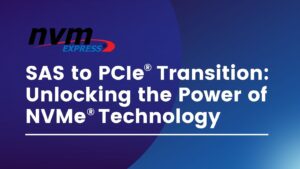
SAS to PCIe® Transition: Unlocking the Power of NVMe® Technology
Blogby Rohit Gupta | Scott Glenn | Jimmy Gomez | Praveen Midha, Western Digital
NVM Express® (NVMe®) technology is a high-performance storage protocol for non-volatile storage media directly connected to the CPU via PCI Express® (PCIe®) interface. PCIe architecture emerged as the next logical storage interface, following Serial Attached SCSI (SAS) and Serial Advanced Technology Attachment (SATA) interfaces, which were not designed for high-speed, non-volatile storage media. PCIe architecture slots directly connect to the CPU, providing memory-like access allowing software stacks to run more efficiently.
Data infrastructure will continue to require improvement in efficiency, utilization, agility, elasticity and scalability as time goes on. Traditional storage protocols and physical interfaces like SATA and SAS will begin showing limitations in their functionality due to hardware boundaries and other factors. Next-generation data centers will rely on shared and multi-tenant architectures which will usher in the transition to NVMe over PCIe architecture, an interface and protocol for high-performance, non-volatile data storage media.
Comparison of SAS vs. NVMe Technology
Next-generation data centers will reduce hardware boundaries, include seamless data movement across the data infrastructures and increased overall system utilization and efficiency. NVMe protocol capitalizes on parallel, low-latency data paths to the underlying storage media, like high performance processor architectures. NVMe SSDs offer significant advantages over SAS SSDs, including higher performance, lower latencies, newer form factors, rich management interface, telemetry support and other enterprise features. A comparison of SAS vs. NVMe technology helps illustrate why the transition from SAS to NVMe SSDs makes both economic and strategic sense.
NVMe SSDs double random mixed IOPS, with 401K for NVMe technology as compared to 189K for SAS SSDs. NVMe SSDs can deliver the same performance with half the number of drives as that of SAS SSDs. NVMe SSDs also offer 44% lower read latencies compared to SAS SSDs, NVMe architecture comparing random read 84 µs, while SAS SSDs compare random read 150 µs. [1]
SAS SSDs have no direct CPU connection through host bus adapters (HBAs) or SAS expanders while NVM directly connects to CPUs in order to reduce hopping and provide better quality of service with faster data access. IOs on NVMe technology can have separate, dedicated queues for multi-tenancy and command prioritization. They can also support long-outstanding IOs and process the chosen IOs for multi-threaded apps. Hosts can push more commands to the devices as compared to SAS protocol.
NVMe technology supported infrastructure offers independent scaling of compute and storage without any significant overheads and supports disaggregated or composable architecture. SAS SSDs have limited form factor footprint while NVMe SSDs offer many more form factors, which allows for more features and customization options.
Conclusion
Traditional storage protocols and physical interfaces were not designed for high-performance and non-volatile storage media. NVMe technology welcomes innovations and opens the door for new low-endurance and high-capacity media. SAS interfaces have limited features and form factors, consume too many CPU cycles and delay delivery of data to applications. Data infrastructure is prioritizing protocols and interfaces that can handle rigorous application workloads with a smaller and more shareable infrastructure footprint.
NVMe SSDs, which are a highly optimized protocol for non-volatile media, are the perfect solution for the evolving needs of the data center. The NVMe protocol eliminates many inefficiencies, improves performance and enables many more enterprise storage features, while also driving new form factors. As the data infrastructure ecosystem continues to evolve, many new innovations are prioritizing NVMe protocol over SAS protocol. The benefits of NVMe protocol solidify the superior status of the technology in comparison to SAS SSDs in enterprise server and storage systems.
For more detailed information on how to transition from SAS to PCIe architecture, please read the full Western Digital whitepaper.
[1] Performance values for example SAS and NVMe SSDs based on Ultrastar® DC SS540 and Ultrastar® DC SN840 SSDs with same capacity and endurance.